Hydroponic Plant Cultivation at Home: A Practical Guide
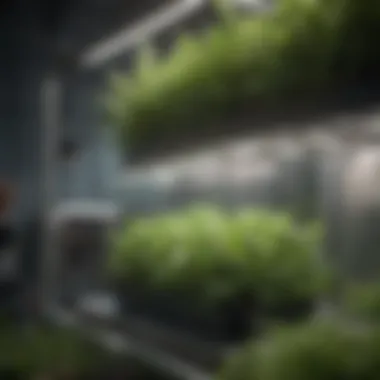
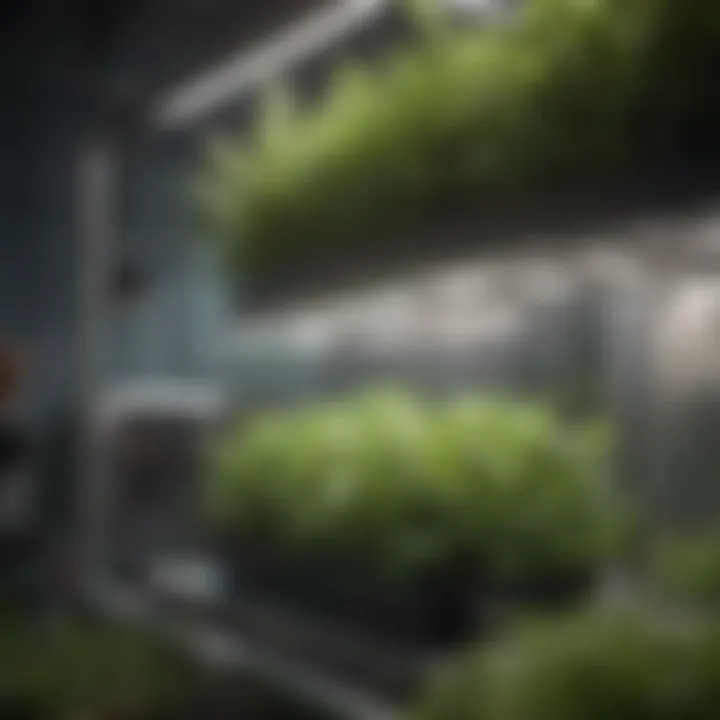
Intro
Hydroponic gardening sits at the intersection of innovation and practicality, allowing individuals to cultivate plants without traditional soil. This method taps into solutions that harness nutrient-rich water, providing an alternative to conventional gardening. With an increased awareness of food sustainability and the desire to produce crops in limited spaces—say, an apartment balcony—more people are turning to this sustainable method of gardening.
Understanding hydroponics is crucial, not only for growing food but also for fostering a deeper awareness of agricultural practices that can yield encouraging results right at home.
Overview of the Topic
Definition and Importance
Hydroponics is a technique where plants grow without soil, directly in a nutrient solution. This practice has gained traction among both amateur and experienced gardeners, offering a myriad of advantages.
- Space Efficiency: A significant boon for urban dwellers, hydroponic systems can be set up indoors or on limited outdoor spaces.
- Water Conservation: It utilizes water more efficiently compared to traditional soil gardening. This makes hydroponics not only a practical choice but also an environmentally friendly one.
- Faster Growth: Many hydroponic methods can accelerate plant growth, sometimes producing higher yields than soil methods.
When exploring hydroponics, one finds that the definition transcends basic horticulture. It's about redefining what gardening means today and making food cultivation more accessible to those who would otherwise find it a laborious task.
Current Trends
Recent trends in hydroponics suggest a growing interest in home gardening. This could be attributed to several factors:
- An Interest in Organic Foods: As health consciousness rises, individuals seek to understand where their food originates. Hydroponics allows for better control over the growing process.
- Technological Advancements: Smart hydroponic systems have emerged, integrating sensors and automation to monitor growth conditions.
- Community Engagement: Platforms like Reddit and Facebook have seen enthusiastic groups sharing how-to guides, tips, and success stories related to home hydroponics. This community aspect fosters a learning environment where beginners can thrive.
Key Techniques and Practices
Step-by-Step Guide
For anyone keen on getting started, here’s a straightforward guide:
- Choose Your System: Options include Deep Water Culture, Nutrient Film Technique, and Aeroponics, among others.
- Select the Right Plants: Leafy greens like lettuce or herbs tend to do well initially.
- Set Up Your System: Follow a reliable tutorial or manufacturer’s instructions to assemble your chosen hydroponics system.
- Monitoring Nutrient Levels: Test the pH and nutrient solution regularly.
- Patience is a Virtue: As plants develop, take notes on their progress, adjusting light and nutrients as needed.
Tools and Equipment Needed
When embarking on this journey, some essential tools include:
- Water Reservoir: A container to hold the nutrient solution.
- Growing Medium: Alternatives like Rockwool or clay pellets.
- Air Pump: Ensures proper oxygenation of the nutrient solution.
- pH Meter or Test Strips: To maintain the right acidity level for optimal plant growth.
"Hydroponics can be a rewarding way to grow healthy food, all while exploring this fascinating world of soil-less agriculture."
Challenges and Solutions
Common Obstacles
Even the most seasoned gardeners encounter hurdles with hydroponics. Here are a few factors that could impede progress:
- Algae Growth: Unwanted algae can sprout when the nutrient solution is exposed to light.
- Pests and Diseases: Plants are still vulnerable to pests, and hydroponics doesn’t eliminate this risk.
- Nutrient Imbalances: Without soil, one miscalculation can quickly turn detrimental to plant health.
Innovative Solutions
Facing obstacles doesn’t mean quitting. Solutions can often be straightforward:
- Prevent Algae: Use opaque reservoirs or keep light away from nutrient solutions.
- Regular Monitoring: Incorporate a routine check for any signs of pests or diseases.
- Track Nutrient Solutions: Use a nutrient management app to help with dosage and timing, improving your chances of success.
In summary, hydroponics offers a practical yet effective way to engage in plant cultivation at home. As the landscape of gardening continues to shift, being adaptable and proactive will be key in overcoming challenges and realizing the full potential of your hydroponic endeavors.
Prelude to Hydroponics
Hydroponics presents an exciting shift in how we grow plants, moving away from traditional soil-based methods to innovative, soil-less cultivation. Understanding this concept is crucial not only for urban gardeners but also for everyone interested in sustainable agriculture practices. As we embark on this journey, let’s break down what hydroponics really entails, its historical evolution, and how it stacks up against conventional gardening methods.
Definition and Overview
Hydroponics involves growing plants using nutrient-rich water instead of soil. This modern technique allows for precise control over the nutrients delivered to the plants, resulting in healthier and more robust growth. In simpler terms, it’s like feeding a plant a balanced diet directly through its roots, rather than relying on soil’s unpredictable variables. The process can be adapted for various scales, from home setups to large commercial operations.
Notably, hydroponics can utilize various systems like Deep Water Culture and Nutrient Film Technique, each with its own merits. This adaptability makes it highly appealing to both novice gardeners and seasoned farmers looking for efficiency and higher yields.
History of Hydroponic Development
The inception of hydroponics isn't a recent phenomenon; it traces back thousands of years. Ancient civilizations like the Babylonians utilized hanging gardens, a primitive form of hydroponics, showcasing an early understanding of plant cultivation without soil. Fast forward to the 20th century, scientists began experimenting with various nutrient solutions in water.
In the 1960s, hydroponics gained traction in the United States, especially within research institutions, focusing on optimizing plant growth in controlled environments. With ongoing advancements in technology and methodology, hydroponics has steadily gained acceptance as a viable agricultural solution, particularly notable in areas where arable land is scarce.
Hydroponics vs. Traditional Gardening
When comparing hydroponics with traditional gardening, a few key differences emerge:
- Soil Dependency: Traditional gardening relies heavily on the quality of soil, which can vary greatly depending on location, making it unpredictable.
- Water Use: Hydroponic systems typically use less water than conventional methods due to direct nutrient delivery.
- Space Efficiency: Hydroponics allows for vertical farming, optimizing space and making it feasible to grow in urban areas.
- Pesticide Use: Without soil as a medium, the chance of soil-borne pests diminishes significantly, reducing the need for harmful pesticides.
In sum, hydroponics presents numerous advantages that cater to modern agricultural needs. Each method has its place, but understanding hydroponics opens doors to sustainable practices that align well with contemporary challenges in agriculture.
As we delve deeper into benefits, systems, and practical applications, you'll see just how transformative hydroponic gardening can be, especially when it's done at home.
Benefits of Hydroponic Gardening
Understanding the advantages of hydroponic gardening is pivotal for anyone considering this innovative approach to plant cultivation. With a distinct shift towards more sustainable and efficient agricultural practices, hydroponics has emerged as a viable solution not only for urban farming but also for home gardeners looking to maximize their growing potential. Here’s a detailed look into the benefits that make hydroponic gardening a worthy endeavor.
Space Efficiency
One of the standout features of hydroponic systems is their remarkable ability to save space. Traditional gardening often demands expansive areas, which can be a luxury many of us do not have. Hydroponics, however, allows plants to be grown vertically or in confined spaces, making it ideal for urban environments. Imagine utilizing a balcony or even a small kitchen countertop to grow a variety of crops. Multi-layered systems can allow for a surprising number of plants in as little as a few square feet. Not only does this give you a lush garden in a limited area, but it also adds a touch of greenery to your living space.
Water Conservation
Water efficiency is becoming increasingly critical in a world facing water shortages. Hydroponic gardening excels in this aspect, using significantly less water compared to traditional soil gardening. In a conventional setup, water is lost through evaporation and drainage. However, in hydroponic systems, water is recirculated, allowing the same water to be used multiple times. It's common for hydroponic operations to use up to 90% less water than traditional gardening methods. This conservation strategy not only saves money on water bills but also contributes to broader eco-friendly practices.
Reduced Pesticide Use
Growing without soil doesn’t just mean a different growing medium; it also leads to fewer pests and diseases. Many hydroponic gardeners report reduced or even eliminated needs for pesticides. This is mainly because the controlled environment reduces exposure to the common pests found in soil. When utilizing hydroponics, the use of natural pest deterrents or organic solutions becomes more feasible and effective. Without the soil harboring pests and diseases, the crops tend to require fewer chemical interventions, resulting in purer produce and healthier plants overall.
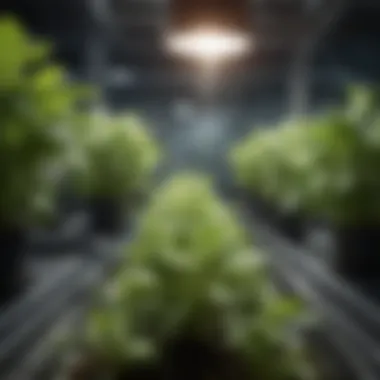

Higher Yield Potential
Hydroponic plants often outpace their soil-grown counterparts in terms of yield. By providing optimal growing conditions, plants can grow faster and produce more. Factors such as enhanced nutrient delivery directly to the roots, ideal oxygen levels in the water, and regulated light exposure contribute to higher growth rates. Many hydroponic systems can produce up to three times more yield per square foot than traditional methods. With hydroponics, you can harvest more from less space, which is not only advantageous for personal consumption but could also turn into a profitable venture if you choose to sell your produce.
Hydroponics rewrites the gardener's handbook—space saving, efficient water use, fewer chemicals, and bumper harvests.
The potential benefits of hydroponic gardening are clear—space efficiency, water conservation, reduced pesticide use, and higher yield potential all contribute to making this method appealing. For aspiring home gardeners, transitioning to hydroponics could very well revolutionize how you approach plant cultivation.
Types of Hydroponic Systems
In the world of hydroponic gardening, selecting the right system is as critical as choosing the plants themselves. Each hydroponic system comes with its unique setup, advantages, and challenges. Understanding these various systems can significantly impact plant growth, yield, and overall gardening experience. This section will explore four prominent types of hydroponic systems: Deep Water Culture, Nutrient Film Technique, Ebb and Flow Systems, and Aeroponics.
Deep Water Culture
Deep Water Culture (DWC) is arguably one of the simplest and most effective hydroponic systems. In this method, plants are suspended in a nutrient-rich water solution, and their roots dangle freely in the solution. An air pump injects oxygen into the water, ensuring that the roots receive the necessary oxygen they require to thrive.
Benefits of Deep Water Culture:
- Simplicity: DWC setups are easy to understand and maintain, making it an excellent choice for beginners.
- Fast Growth: The ample oxygen and nutrients in the water can lead to faster growth rates compared to traditional soil gardening.
- Full Control: Growers can easily monitor and adjust nutrient levels to meet the plants' demands.
However, it's essential to keep an eye on water temperatures and the oxygen levels in your reservoir. If the water gets too warm, it can harm plant health and promote diseases.
Nutrient Film Technique
The Nutrient Film Technique (NFT) is known for its efficiency in nutrient delivery. In this system, a continuous flow of nutrient solution is delivered to the plant roots, which are situated in a sloped trough or channel. As the solution flows over the roots, it allows them to absorb necessary nutrients while letting excess water drain back into the reservoir.
Key Considerations for NFT:
- Resource Efficiency: This method utilizes water and nutrients more sparingly compared to other systems, making it environmentally friendly.
- Root Health: The constant flow encourages healthy root growth without drowning the roots, as they get exposed to air numerous times.
On the flip side, maintaining proper pump operation is crucial. A pump failure can quickly lead to nutrient deprivation and potentially endanger your plants.
Ebb and Flow Systems
Ebb and Flow systems, often referred to as flood-and-drain systems, work by flooding the grow bed with nutrient solution and then draining it back into the reservoir. This cyclical flooding allows the roots to receive nutrients and oxygen effectively.
Strengths of Ebb and Flow Systems:
- Flexibility: You can grow various plant types using this system, as the flood duration and frequency can be adjusted as needed.
- Nutrient Distribution: The flooding action pushes oxygen, nutrients, and water through the root zone, ensuring comprehensive exposure.
That being said, timing is everything here. Over-flooding can drown plants, while too little can lead to dry roots, emphasizing the need for careful timing and monitoring of your cycle.
Aeroponics
Aeroponics brings something different to the table, as it suspends plants in air and mists their roots with a nutrient solution. This method allows for excellent oxygenation and faster growth rates, taking plant cultivation to another level.
Merits of Aeroponics:
- Space-Efficient: With the absence of a growing medium, vertical setups are possible, maximizing space usage.
- High Yield Potential: The misting delivers nutrients while allowing roots extensive access to oxygen, promoting rapid growth.
However, because the roots are so exposed, any failure in the misting system can quickly lead to root desiccation. Being vigilant about system operation is crucial to prevent disaster.
In summary, understanding the various types of hydroponic systems can help you determine which method aligns best with your specific goals, resources, and plant choices. Each system has its own fingerprints of advantages and challenges, often making it worthwhile to experiment and find out what suits your style and situation the best.
"The right hydroponic system can transform your gardening experience and lead to more efficient plant growth. Choose wisely!"
For more information, you might find Wikipedia a useful resource.
Essential Components for Hydroponic Setup
Setting up a hydroponic system at home isn't just a matter of throwing some plants in water and hoping for the best. It requires an understanding of the essential components that contribute to a healthy and productive environment for your plants. This section will dive into the key ingredients needed for a successful hydroponic setup, detailing each one's role and importance in fostering growth.
Growing Medium
While hydroponics is primarily about growing plants without soil, the need for a growing medium remains crucial. The growing medium serves several purposes. It acts as a support structure for the plants, helps maintain moisture and is responsible for the delivery of nutrients. Common materials used include Rockwool, clay pellets, and coco coir. Each has unique attributes:
- Rockwool: Great for its excellent moisture retention and aeration properties, but can sometimes be a bit tricky to handle.
- Coco Coir: A sustainable option made from coconut husks, this medium is pH neutral and provides both air and water retention.
- Clay Pellets: These are pH neutral and provide good drainage. They can also be reused, making them an eco-friendly choice.
Choosing the right medium can make a world of difference. It’s essential to understand the specific needs of the plants you are cultivating, as different plants may thrive better in varied environments.
Nutrient Solutions
The lifeblood of any hydroponic system is its nutrient solution. Unlike traditional gardening where plants draw nutrients from soil, hydroponic plants rely entirely on a carefully balanced nutrient mix delivered directly to their roots. This is typically a blend of macro and micronutrients, including:
- Nitrogen (N): For leaf growth
- Phosphorus (P): For root and flower development
- Potassium (K): For overall plant health
Those elements are key players, but there are also calcium, magnesium and various micronutrients like iron and manganese that play a critical role in plant vitality. Monitoring and adjusting nutrient concentrations according to the growth stage of the plants can lead to impressive results and higher yields.
Lighting Requirements
Lighting is another fundamental factor in a hydroponic setup. Since plants rely on photosynthesis, providing the right type and amount of light is vital for growth. It’s important to consider:
- Type of Light: LED lights are popular due to their energy efficiency and tailored light spectrum. Fluorescent lights can work well too but may not provide the same intensity. Grow lights come in a range of spectrums designed for different phases of plant growth.
- Duration: Most plants benefit from around 12 to 16 hours of light per day. It is crucial to balance light periods with dark time, allowing the plants to 'rest'.
A good lighting strategy can turn a struggling garden into a blooming success, while poor lighting can leave plants wilting in despair.
pH and EC Monitoring
The pH level and electrical conductivity (EC) of your hydroponic solution are like the pulse of your system. Monitoring these elements is essential to maintaining a healthy growing environment.
- pH: The ideal pH for most hydroponic crops typically ranges between 5.5 and 6.5. Deviations can affect nutrient absorption. An acidity or alkalinity swing can throw plants into a tailspin, making them susceptible to nutrient lockout.
- EC: This measures the concentration of nutrients in the solution. A higher EC means more nutrients, while a lower EC indicates diluted solutions. Adjusting these values appropriately can help ensure plants receive exactly what they need.
Having reliable pH and EC meters, and checking them regularly, is highly recommended. A small adjustment today can yield big changes tomorrow.
"The right components can make the difference between a flourishing garden and a meager yield."
To wrap it up, the essential components in hydroponics—growing medium, nutrient solutions, lighting, and monitoring pH and EC—form an interconnected web. A sound understanding of each and a commitment to optimal conditions are the keys to successful hydroponic cultivation at home. By focusing on these intricate details, you can develop a thriving hydroponic ecosystem that meets your gardening aspirations.
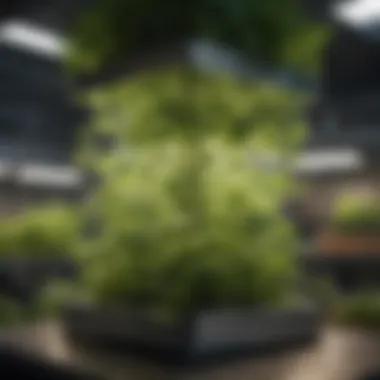

Choosing the Right Plants for Hydroponics
Selecting the right plants for your hydroponic system is crucial. Different plants thrive under unique conditions, and choosing those that align with your setup can lead to flourishing plants and a bountiful harvest. Hydroponics, being a soil-less method, relies heavily on nutrient solutions, light, and proper care. Thus, understanding what types of plants can grow efficiently in such environments is essential. The right choice not only affects yield and growth rate but can also influence how much time and resources you invest in your gardening venture.
Leafy Greens: Lettuce and Spinach
Leafy greens such as lettuce and spinach are often the bread and butter of hydroponics. They are typically quite forgiving, making them an attractive choice for beginners. Lettuce, for instance, grows quickly, with some varieties reaching maturity in as little as four weeks. Spinach is another great candidate; it prefers cooler temperatures, which can easily be maintained in a controlled hydroponic setup.
These greens possess shallow root systems, thriving in shallow water cultures or other systems that allow roots to access plenty of oxygen. Additionally, they require less complex nutrient solutions compared to more demanding plants, making them cost-effective for aquaponic gardeners. Their fast turnover also means you can enjoy multiple harvests within a year.
Herbs: Basil and Mint
Herbs like basil and mint can elevate your hydroponic garden to a new level, both in terms of flavor and fragrance. Basil, especially, is a fan favorite. Not only is it easy to grow, but it also brings a delightful aroma to your home. It enjoys well-drained moisture and ample light, needing around 14 to 16 hours of light per day. Growing basil in hydroponics ensures a constant supply of fresh leaves, which can be the cherry on top for many culinary dishes.
Mint, on the other hand, can be a bit assertive in terms of its growing habits. It may spread like wildfire, so careful consideration of its placement is wise. Hydroponically, mint thrives remarkably well, often yielding lush foliage without the need for much fertilizer. Just be sure to contain its growth to avoid an unwanted takeover in your system.
Fruiting Plants: Tomatoes and Peppers
When it comes to fruiting plants, tomatoes and peppers are the champions of many hydroponic setups. Tomatoes require some more attention than leafy greens or herbs but yield delicious fruits in return. The extensive root system necessitates more space, and staking methods may also be employed to support growth. There are many varieties available, from cherry to beefsteak, each offering different flavors and uses.
Peppers come in a variety of shapes, sizes, and heat levels. They are quite receptive to hydroponics, thriving in nutrient-rich solutions. They generally require adequate light—often more than leafy greens, so planning your setup accordingly is vital. With patience and care, you can enjoy a rather productive harvest from your peppers and tomatoes.
Resilient Varieties for Beginners
If you're still feeling a bit hesitant about planting, going with resilient varieties can make the journey smoother. Kale, for instance, is hard to kill and can adapt well to various conditions. It's jam-packed with nutrients and can be grown year-round. Swiss chard is another solid option; like kale, it offers not just beauty but nutrition as well.
Many enthusiasts find strawberries are surprisingly manageable when grown hydroponically. While they do have specific needs, with a bit of effort, you can produce sweet, juicy fruits right in your living space.
Remember, the best approach is to start small and choose plants that excite you. Happy gardening!
Setting Up a Hydroponic System at Home
Setting up a hydroponic system at home opens up a world of possibilities for growing healthy plants without soil. This section is pivotal because it lays the foundation for every successful crop. By understanding the relevant elements and considerations, you’ll equip yourself with the knowledge to create an efficient, productive garden. Choosing to cultivate plants hydroponically can not only lead to a healthier harvest but also brings along several benefits such as space conservation and enhanced plant growth.
Planning Your Space
Before diving headfirst into hydroponics, it is crucial to evaluate and plan your space. Look around your home—do you have a spare room, a sunny corner of your living room, or perhaps a garage that can be converted into a mini-garden? Before you get too excited, ensure that your selected area has adequate sunlight or access to grow lights.
In planning, consider factors like:
- Size of the area: How many plants do you aim to grow?
- Access to water: Hydroponic systems need a good water supply.
- Ventilation: Proper airflow can make or break your hydroponic experience.
This space planning step is like laying down the groundwork for a house; it can be the difference between thriving plants and a frustrating setup.
Gathering Resources and Materials
Once you know where your garden will live, it’s time to gather your resources and materials. Hydroponics can sound intimidating, but it's really about gathering some basic tools and supplies. Here's what you might need:
- Hydroponic system kit: Depending on the type of system you choose, from deep water culture to nutrient film techniques, there are plenty of kits available.
- Growing medium: Options like clay pellets, rock wool, or coconut coir are suitable for seedlings.
- Water pump and air pump: Essential for keeping nutrients circulating and ensuring roots breathe.
Don’t skimp on quality; investing in good materials pays off down the line. Nothing is worse than setting things up only to find cheap parts aren’t functioning properly.
Assembling Your Hydroponic System
Assembling your hydroponic system can feel like putting together a puzzle. Take your time, follow the instructions (or video guides found on different platforms), and double-check each piece as you go. A few key points to remember:
- Follow the layout recommended with your kit. Each system is designed with a specific flow in mind.
- Seal connections well to avoid leaks later.
- Position your lights correctly for maximum plant coverage.
The better you assemble your system, the smoother it will operate, leading to healthier plants. Seeing it all come together is like watching a work of art develop.
Adjusting Environmental Conditions
With your system up and running, environmental control plays a critical role. No plant can thrive in a harsh environment. Here are several factors to consider when adjusting:
- Temperature: Most plants prefer warmer temperatures, but this varies depending on the species. Keep an eye on thermometer readings.
- Humidity: Many plants thrive in a certain range of humidity. You might need a humidifier or dehumidifier to get it just right.
- Light duration: Plants need light, but the duration and intensity are crucial. Use timers to maintain a consistent schedule.
To sum it up, creating the right environment for your hydroponic system is akin to creating a comfortable home for a pet. It requires ongoing attention and adjustment, but the reward is well worth the effort.
"A hydroponic garden might take more planning, but it can yield fresh produce like you won’t believe. Taking time upfront saves heaps of headaches later."
By diving into these details, you set not only the stage for long-term cultivation, but also establish a deep understanding of hydroponic gardening that can lead to fruitful results.
Maintenance and Care of Hydroponic Plants
Maintaining hydroponic plants requires a mix of regular attention, precision, and a dash of patience. Just like any good recipe, keeping your plants thriving involves carefully measuring inputs and making adjustments as needed. When it comes to hydroponics, this means monitoring nutrients, water levels, and the physical condition of plants themselves. If you stay on top of these factors, you’ll more likely enjoy a bountiful harvest.
Routine Nutrient Management
One of the cornerstones of hydroponic gardening is nutrient management. Unlike traditional soil gardening where nutrients are naturally replenished, hydroponics relies on nutrient solutions that you mix and administer. Regularly checking and adjusting the nutrient concentration is crucial. Plants will signal you if they’re feeling under the weather — discolored leaves or stunted growth can be red flags.
To maintain an optimal nutrient solution:
- Start with a well-balanced formula. Choose a nutrient mix designed specifically for hydroponics. Brands like General Hydroponics or Advanced Nutrients often come highly recommended.
- Mix according to instructions. Always follow the label guidelines for dosages; more isn’t necessarily better here.
- Check the pH level. Ideally, you want to maintain a pH range between 5.5 and 6.5, as this is where most plants absorb nutrients best.
- Monitor Electrical Conductivity (EC). Tracking EC provides insight into how concentrated your nutrient solution is. Generally, an EC level around 1.5 – 2.5 mS/cm is suitable for most plants.
Monitor Water Levels
Water plays a pivotal role in hydroponics. It’s not just a growing medium; it's a life source. Keeping an eye on water levels and quality will help ensure your plants don’t suffer from drought or drown in overly saturated roots. It’s a delicate balance.
- Check regularly. Establish a routine to monitor your water levels. Depending on your system, you may find that your water levels drop quite quickly, especially in a Deep Water Culture system.
- Top it off. If levels dip below a certain point, add water that's in line with your nutrient strategy. For example, if your nutrient solution is low, make sure to top off with the same mix to keep levels balanced.
- Inspect for cleanliness. Algae and sediment can build up over time, affecting the quality of the water. Change the nutrient solution for a fresh mix every 2 to 3 weeks to prevent this buildup.
Remember: Water quality is as important as quantity. Always use filtered or distilled water if possible to minimize the introduction of unwanted chemicals.
Pruning and Harvesting Techniques
Pruning is an often-overlooked yet essential part of maintaining your hydroponic plants. It's not just about tidying up; smart pruning encourages growth, airflow, and ultimately, a higher quality yield.
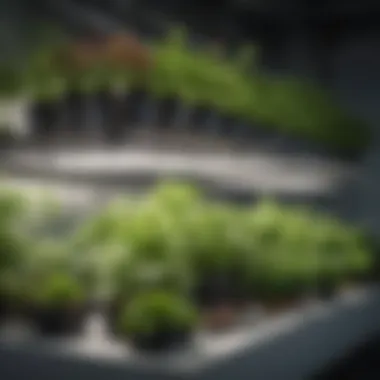

- Timing is key. Regularly check for yellowed or wilted leaves and remove them. This process helps redistribute nutrients to healthier parts of the plant. The earlier you catch them, the more energy you save your plant.
- Focus on structure. When plants grow tall and bushy, they can become overcrowded. Thin them out by pinching back the tops or cutting back on branches that are crowding the center. This enhances light exposure and air circulation.
- Be gentle but decisive. When harvesting, use clean, sharp tools to minimize plant stress. Cut just above a node, encouraging regrowth in other parts.
Keeping a vigilant eye on these facets of plant care not only promotes healthier growth but also sets the stage for a successful growing experience. The time you invest in maintenance now will echo in your future harvests, making all the effort worthwhile.
Troubleshooting Common Issues
Hydroponic gardening, while rewarding, can sometimes feel like navigating a minefield of potential issues. Given the absence of soil, the challenges experienced in conventional gardening can take new forms. Understanding the nuances of troubleshooting can make the difference between a thriving garden and one that falls flat. In this section, we’ll delve into identifying nutrient deficiencies, managing pests, and controlling algae growth—key areas that can impact your hydroponic system’s overall health.
Identifying Nutrient Deficiencies
A significant component of a successful hydroponic garden is ensuring that plants receive the right nutrients. Since they're grown in a soilless environment, it’s essential to monitor nutrient levels in your solution closely. Deficiencies can manifest in various ways, and recognizing these signs early on can save your plants from serious harm.
Some common symptoms include:
- Yellowing Leaves: Often indicates a nitrogen deficiency, which is vital for plant growth.
- Brown Leaf Tips: Might be a sign of potassium or magnesium deficiency.
- Stunted Growth: A general sign that plants aren't getting enough nutrients, potentially due to imbalanced pH levels.
Checking your nutrient solution regularly and adjusting the concentrations as needed keeps plants healthy. Additionally, utilizing pH testing kits to ensure a balanced environment can prevent many nutrient-related problems.
"Monitoring your plants closely can prevent major issues before they begin. Healthy plants are often just one check away from thriving."
Pest Management in Hydroponics
Even without soil, pests can find their way into your hydroponic setup. Some might think that the absence of soil keeps unwanted guests at bay, but sadly, that's not the case. Pests like aphids, spider mites, and whiteflies can wreak havoc if left unchecked.
To effectively manage pests in your hydroponic garden, keep these strategies in mind:
- Regular Inspections: Routinely check plants for signs of pests. Early detection helps to manage outbreaks before they escalate.
- Natural Predators: Introducing beneficial insects, such as ladybugs, can help keep pest populations in check.
- Neem Oil: This natural pesticide is effective against a wide range of pests and is safe to use in hydroponics when diluted properly.
Furthermore, it’s important to ensure your growing area is well-ventilated, as a lack of airflow can create an environment conducive to infestations.
Dealing with Algae Growth
Algae can quickly become a menace within hydroponic systems, typically arising from excessive light exposure or stagnant water. While some algae are harmless, they can compete with plants for essential nutrients and even harm the roots. Thus, addressing algae growth is vital for maintaining a healthy hydroponic environment.
Here’s how you can tackle this issue:
- Regulate Light Exposure: Keep the light intense but not excessive. Covering nutrient reservoirs with opaque materials can effectively reduce light penetration and inhibit algae growth.
- Increase Water Movement: Ensuring water circulates effectively can discourage stagnant areas where algae thrive. Consider using pumps or air stones to improve aeration.
- Regular Cleaning: Don’t underestimate the power of cleanliness. Regularly cleaning your reservoir and any related equipment helps prevent algae from taking hold.
By proactively identifying deficiencies, managing pests, and controlling algae, you can nurture a vibrant hydroponic garden that flourishes despite the potential hurdles.
Sustainability in Hydroponics
Sustainability in hydroponics plays a pivotal role in how we approach food production today. As the world grapples with environmental issues like climate change, overpopulation, and resource depletion, the adoption of hydroponic systems emerges not just as a solution, but as a necessity. This section aims to unpack the multifaceted layers of sustainability within hydroponics, paying special attention to renewable resource management, waste minimization, and the broader impact on our communities.
Renewable Resources Utilization
Utilizing renewable resources is at the heart of sustainable hydroponic practices. This means harnessing energy and materials that can be replenished, reducing reliance on finite resources. For instance, many home grow setups use solar panels to power lighting and pumps. Imagine a scenario where your indoor garden thrives under the nurturing rays of the sun—now that’s both efficient and environmentally friendly.
Also, composting materials can serve as a nutrient source, transforming kitchen scraps into a boon for plant growth. Emphasizing sustainable resources, like recycled plastic for systems or locally sourced agricultural inputs, minimizes the carbon footprint associated with long-distance transportation.
Waste Management Practices
Waste management stands as a crucial pillar in maintaining the sustainability of hydroponics. To maximize efficiency, it is important to implement practices that minimize waste production while ensuring productive output. Hydroponic systems can generate waste in the form of nutrient solution runoff or plant detritus. However, this waste can be an asset if managed correctly.
For instance, excess nutrient solutions can be collected and reused, making the process more economical and ecologically sound. Additionally, compostable materials from plant trimming can be repurposed for composting or even as biofuel in some advanced setups. Each bit of waste, therefore, becomes an opportunity for recycling or repurposing.
"Proper waste management transforms potential pollution into practical solutions."
Community Impact and Education
The ripple effects of sustainable hydroponics extend far beyond individual gardens. It fosters a sense of community engagement, where knowledge and resources are shared among residents. Local workshops can educate aspiring urban gardeners about efficient practices, creating a network of informed individuals who champion green methods. For example, community gardens often adopt hydroponic systems, demonstrating the viability and benefits of soil-less cultivation to people of all backgrounds.
Moreover, initiatives can partner with schools to introduce students to these sustainable practices, igniting a passion for food production that blends education with responsibility. In essence, the fusion of culture and agriculture catalyzes a more sustainable future, grounded in collective effort.
By weaving sustainability into the fabric of hydroponics, we not only nurture our plants but also protect the environment for future generations while building a more ecologically aware and engaged community.
Future Trends in Hydroponic Gardening
As hydroponics grows from a niche interest to mainstream gardening practice, understanding future trends is vital. The shifts in technology, preferences, and global challenges shape how this innovative gardening method evolves. In this section, we'll explore crucial elements regarding these trends which not only aim to enhance hydroponic operations but also to promote sustainability and efficiency.
Technological Innovations
One cannot discuss the future of hydroponics without mentioning technology. The field is witnessing advancements that are redefining what is possible. Smart systems, for instance, are emerging that utilize sensors to monitor everything from nutrient levels to pH balance. With IoT (Internet of Things) integration, gardeners can receive real-time data on their plants' conditions, allowing for immediate adjustments. This data-driven approach makes opportunities for optimization nearly endless.
Furthermore, researchers are constantly exploring ways to introduce automation into hydroponic systems. Automated nutrient delivery systems and robotic arms for planting and harvesting are becoming more common in commercial hydroponic farms. These innovations simplify the operation, making it less labor-intensive while boosting productivity and reducing human error.
"Technological advancements in hydroponics are not just enhancements; they're game-changers that promise to increase efficiency and yield dramatically."
Integration with Urban Farming
As urban spaces continue to grow, the integration of hydroponics into urban farming is more than just a passing trend—it's a necessity. Cities are facing increasing pressure to produce food locally. Hydroponic systems lend themselves well to this scenario because they require less space compared to traditional gardening. Vertical farms utilizing hydroponics can be established in warehouses or rooftops, providing fresh produce to city dwellers while utilizing smart space management.
Moreover, community-based urban hydroponic projects have popped up in response to food deserts and local food insecurity, fostering not just food production but community engagement. These integrative approaches empower citizens to participate actively in their food systems, enhancing sustainability and resilience.
Potential for Large Scale Implementation
Looking further down the line, large scale implementation of hydroponic systems holds significant promise. Large agribusinesses are starting to take notice of the benefits of hydroponics, including reduced water usage and higher crop yields. As climate change continues to threaten traditional farming practices, the shift toward hydroponics can serve as a hedge against these uncertainties.
Additionally, regional initiatives aimed at supporting hydroponic farms can help improve food distribution networks, especially in areas facing agricultural hardships. This potential for large-scale implementation not only points to economic opportunities but also addresses pressing food security issues globally.
Ending
The conclusion serves as a vital pivot in understanding hydroponic gardening at home. It encapsulates the lessons learned throughout the article, reinforcing the idea that engaging in soil-less cultivation is not only feasible but also offers numerous benefits. From water conservation to maximizing space efficiency, these insights highlight why hydroponics has found its way into the homes of many gardening enthusiasts.
The importance of sustainable practices in hydroponics can’t be overstated. By embracing renewable resources and smart waste management, practitioners are putting their good foot forward in contributing to a more sustainable future.
In summary, this practical guide has provided ample knowledge for both newcomers and seasoned growers. Anyone willing to delve into hydroponic techniques will find value in understanding the systems, care, and potential challenges associated with this unique form of agriculture.
"Knowledge is the first step towards effective implementation."
Summary of Key Points
- Understanding Hydroponics: The article explored what hydroponics is and its advantages over traditional gardening. The emphasis was on its adaptability in urban settings where space is a premium.
- Methods and Systems: Different types of hydroponic systems were discussed, including Deep Water Culture, Nutrient Film Technique, and Ebb and Flow Systems, each with distinct setups and benefits.
- Components for Success: Key components such as growing medium, nutrient solutions, and proper lighting were highlighted as crucial for a healthy hydroponic garden.
- Plant Selection: Not all plants thrive in hydroponics, so choosing the right varieties is essential, especially for beginners. Leafy greens, herbs, and certain fruiting plants were recommended.
- Maintenance and Troubleshooting: Regular nutrient management, water level monitoring, and recognizing pest issues are important for sustaining plant health in a hydroponic system.
- Sustainability and Community: The impact of hydroponics extends beyond individual gardens. It promotes sustainable practices and can encourage community involvement in local farming initiatives.
Encouragement for Home Hydroponics
The journey into hydroponic gardening is an exciting one, offering both challenges and rewards. For those who feel the itch to plant, hydroponics can provide an excellent starting point. While it may seem daunting at first, the learning curve can be an opportunity to cultivate not just plants, but skills.
Whether you live in a city apartment or have a spacious backyard, hydroponics allows for flexibility. It invites creativity in how we think about growing food. As more people recognize the need for sustainable practices in food production, there's never been a better time to dive into hydroponics. Success doesn’t come overnight, but determination and a willingness to learn can make all the difference.
So, pick your system, gather your materials, and start this rewarding endeavor. The world of hydroponics awaits, and with it, the chance to revolutionize your approach to gardening!



